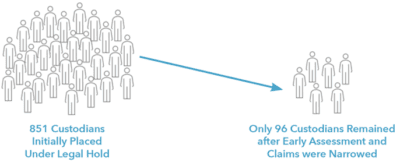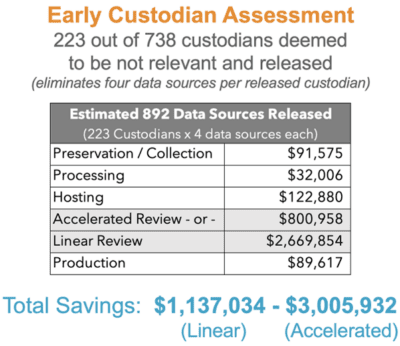Remember when we discussed how the amount of data created in the world was 0.1 zettabytes in 2005 with a trajectory to rise to 163 zettabytes by 2025 (for non-math nerds, that’s a 162,900% increase)? With this kind of exponential data growth, effective data management has become a critical challenge for organizations, causing corporate heartburn. Indeed, over 95% of global organizations face a need to manage unstructured data, with over 40 percent saying they must do so on a frequent basis.[1]
Organizations often incur unnecessary costs by retaining data that no longer has business value. This is commonly referred to as Redundant, Obsolete and Trivial data (ROT). Storing ROT not only adds unnecessary expense for data retention, it also adds considerable risk to an organization from a data privacy compliance, data loss prevention, eDiscovery, information protection, and cybersecurity standpoint. For example,
Data Remediation – Prescription #1
Enter the discipline of data remediation. Data remediation is a critical hygiene process for effective data management, storage, and protection. The word “remediation” derives from the word “remedy,” which means to correct a problem. In the case of ROT, the problem is corrected by identifying, categorizing, replacing, modifying, cleansing, and/or deleting it, thereby deriving optimum value out of your organization’s data, while reducing risk associated with it.
Remediation enables your organization to manage the cost and risk associated with your data, and having a formal and consistent process to remediate your data is critical to those goals.
The heartburn is gone, right?
Litigation Holds – A Trigger that Can Inflame Corporate Heartburn
When your company is involved in a dispute, you must issue a litigation hold to affected custodians to comply with your legal duty to preserve. FRCP Rule 37(e) addresses sanctions for parties that fail to preserve “electronically stored information,” and Lexis and Westlaw are replete with examples of judges making liberal use of the rule. The sanctions can be severe, even resulting in dismissal or default judgment when there is “intent to deprive” another party of information. Even when less severe sanctions are imposed, the financial damages and the cost of motion practice will cause more than a mild case of indigestion. To avoid sanctionable data loss, organizations issue litigation holds to custodians and IT managers who are in control of the data responsive to the matter.
When that happens, a data remediation program suddenly grinds to a halt.
The data under hold may be stored across several locations – workstations, servers, mobile devices, and cloud repositories. Steps can’t be taken to eliminate the data while it remains under a litigation hold. Sure, it can be effectively remediated when the litigation ends, but that litigation could conceivably last for years, which means the litigation hold could stay in place for years as well. And it gets worse. There is a snowball effect. Data on hold is fair game for other litigation that is subsequently filed, resulting in never-ending preservation. Multiply the effect by matters and custodians, and the ability to keep a data remediation program running smoothly gets complicated quickly.
Additionally, companies must look at the impact legal holds have on overall eDiscovery costs — from preservation and collection through processing, review, and production — as well as the amount of data being stored for each custodian, which quickly adds up as well. For example:
Original Media: For each custodian, data is stored on original media; however, secondary working copies or backups are often kept to ensure the data is preserved in case the original media is lost.
Collection: When that data is collected, all that data is duplicated for further action .
Processing: When the collected data is processed, data volumes increase due to normal decompression. And then, even more files and records are generated — such as searchable text files, metadata, audio and video transcriptions, foreign language translations, and possibly images (if documents are imaged during processing).
Review: The review process generates additional metadata, such as responsiveness and privilege determinations, issue coding, and redaction information. If the files aren’t already imaged, an image of documents being redacted may be generated as well.
Production: Another copy of the documents is created when exporting the responsive and non-privileged documents from the review platform. This may include any or all native files, metadata, text files, and image files.
Depositions & Motions: Documents are marked as exhibits through depositions or for motion support and provided to experts for evaluation.
Presentation: Finally, documents are loaded into a presentation platform for use as exhibits in trial.
Now the organization is back in the same situation – storing redundant copies of the same data for extended periods of time, driving up costs and risk. It’s enough to give any corporate data manager a major case of heartburn.
Realigning Custodian Litigation Holds Throughout the Case – Prescription #2
The faulty assumption that many organizations apply is that data must be kept on hold for all potentially responsive custodians for the lifecycle of the case. This is unnecessary. You can realign custodian litigation holds throughout the case, eliminating redundant copies of custodian data and applying routine and standard data remediation processes to manage costs and risk.
There are at least two opportunities for realigning custodian litigation holds during the case:
During Early Scoping: By scoping the case and conducting custodian surveys and interviews early, legal teams develop critical insight that allows for targeting and reduction of the number of custodians under hold – even before collecting their data. The reduction in costs and preservation risk will be significant. Of course, documenting the process is key to defensibility if opposing counsel challenges any preservation or hold practices.
As the Case Progresses: The set of claims contained in the initial petition when the case is filed are almost never the same set of claims downstream. Throughout much of the case, the claims are disputed, negotiated, and often narrowed – either through negotiation between the parties or through dispute resolution via court rulings during the case. The key is to iteratively re-evaluate the relevance of custodians as the claims are narrowed, providing additional opportunities to remove custodians from litigation hold or remove specific data sources for custodians under hold — or both.
Two Case Studies That Illustrate the Cost Savings of Litigation Hold Realignment
The following two examples — based on actual cases — quantify the potential cost savings associated with periodic realignment of custodian litigation holds throughout the litigation lifecycle. In this first example, 851 custodians were initially put on hold. However, 414 of them were released after early assessment of the custodians and another 341 were released after the claims in the case were narrowed, leaving only 96 custodians for which litigation holds were retained throughout the lifecycle of the case.

Figure 1: Reduction in Custodians Associated with Litigation Hold Realignment
In the second example, 223 out of 738 custodians were deemed to be not relevant to the case and were released from litigation hold. Each released custodian had an average of four data sources that were released from hold and placed back into routine data remediation processes. Depending on the timing for releasing the custodians and the type of review contemplated, the cost savings were estimated to be $1 million to over $3 million!

Figure 2: Potential Cost Savings Associated with Litigation Hold Realignment
Conclusion
If unchecked, litigation will disrupt a company’s data remediation strategy, and create unnecessary corporate “heartburn.” Litigation holds force companies to suspend normal remediation procedures for extended periods, and they cause new remediation problems via the creation of additional data during the discovery workflow.
Through an effective data remediation strategy, your company can organize unstructured data, reduce security risks, adhere to regulatory and legal compliance, and ultimately reduce operational costs. Periodic realignment of custodian litigation holds throughout the litigation lifecycle is the “antacid” to your corporate heartburn. Not only does it enable an organization’s data remediation process to be applied with less interruption, it also saves considerable litigation time and cost.
Oh, what a relief it is!
[1] https://www.forbes.com/sites/rkulkarni/2019/02/07/big-data-goes-big/?sh=45e7979220d7
